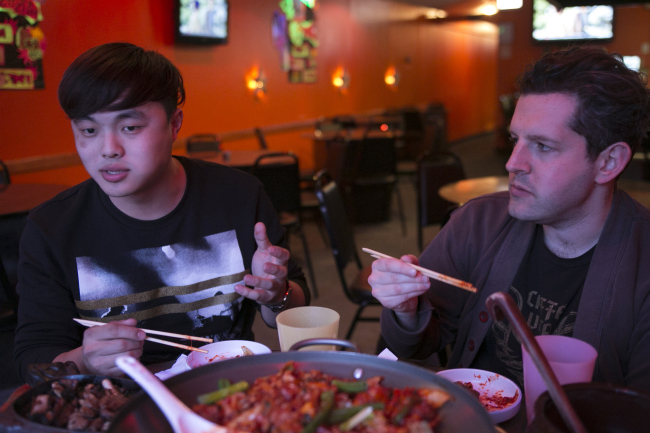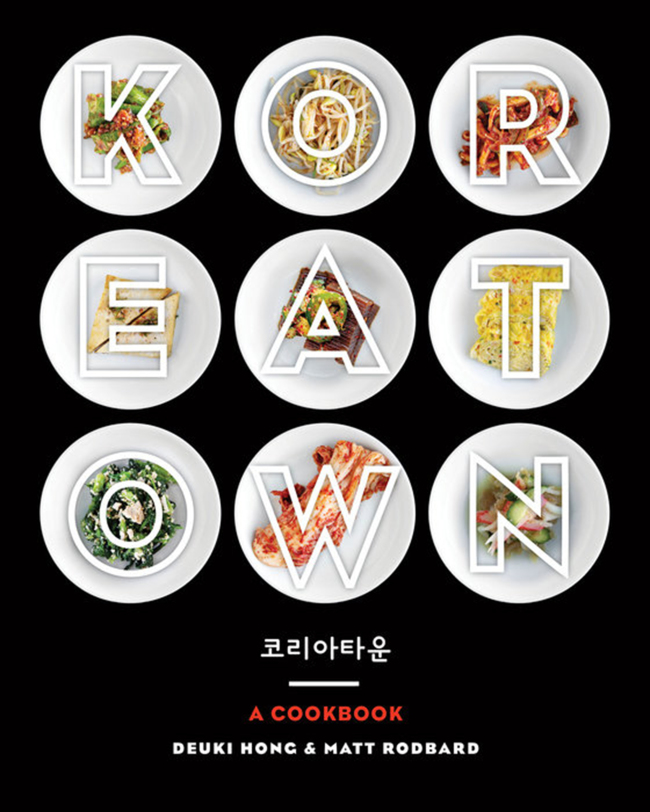“Koreatown: A Cookbook” (Clarkson Potter, $30) is a cookbook, yes, but chef Deuki Hong and journalist Matt Rodbard go further than recipes, distilling two years of research, interviews and dining across the United States into what they write is “a candid and uncompromised snapshot of what it‘s like to eat and drink in Korean-American communities today.”
“For me, coming as a Korean-American, there’s a sense of pride,” said Hong, who along with Rodbard met me at Dancen, a small Korean grill restaurant in Chicago's Lincoln Square, to talk about the book over dinner. The 26-year-old chef of New York City’s super-hot Korean barbecue restaurant, Kang Ho Dong Baekjeong, said the pair had to define the word “Koreatown” before the work could be written.
“For me, coming as a Korean-American, there’s a sense of pride,” said Hong, who along with Rodbard met me at Dancen, a small Korean grill restaurant in Chicago's Lincoln Square, to talk about the book over dinner. The 26-year-old chef of New York City’s super-hot Korean barbecue restaurant, Kang Ho Dong Baekjeong, said the pair had to define the word “Koreatown” before the work could be written.

“We really said it's not a place; it really is a mentality. It really is a way of thinking, that Korean-American hustle and grit. We could be in the middle of Arkansas, and if there’s a Korean restaurant across the street from a Korean laundromat, that, to us, is Koreatown,” he said. “We knew about New York. We knew about Los Angeles. We had an idea about Chicago. But going to Atlanta? Going to Wisconsin? ... We didn't know we had invaded a lot of America in an awesome way. At the end of the day, they’re cooking the food. Koreans are very prideful that way.”
Korean food is, to quote Rodbard, “having a moment” right now. He sees it as partially due to a growing interest in Asian cuisines -- “Everyone is rising right now.” Another factor, he said, is that Korean-Americans are embracing their heritage in restaurant kitchens. Chefs who, Rodbard said, may have been cooking traditional French, Spanish or Italian fare are realizing their mother's Korean bean-paste soup is so good that others might be interested in it too. The pair also note in the book that “chefs of all backgrounds” are turning to Korean ingredients and flavors for their cooking.
“You can’t get sick of eating Korean food,” Rodbard insisted. “The food doesn't weigh on you like other foods. It’s exciting on the palate, exciting on the tongue.”

Hong and Rodbard write that there are about 2 million people of Korean heritage living in the United States and that “in each of these communities, big and small, society revolves around clusters of restaurants that serve the traditional foods of the motherland.” What they set out to do was to show how this “rich food culture” could be both traditional and “distinctly American.” And they wanted to expose home cooks to a wide array of Korean foods, not just the kimchi tacos, fried chicken and barbecue that are so popular now. Hong proudly notes the book's largest chapter is devoted to soups and stews. Barbecue, he adds, is the smallest. Also, right up front, is a glossary of equipment and ingredients, including a useful pictorial guide to Korean produce.
The book’s more than 100 recipes are aimed squarely at home cooks. Indeed, the pair developed the recipes by shopping at a local Asian market and toting grocery bags up three flights of stairs to cook on an electric stove in Hong's bachelor pad. (There’s a wonderful essay on how to cook Korean at home without annoying your neighbors.)
“We never did a cookbook, so we didn't know the process. We literally did it how you would do it. You would go shopping in a local Asian market, go to your house and develop these recipes,” Hong recalled. “If we can execute these recipes in a New York City apartment kitchen, they can be done anywhere.”
(Tribune Content Agency)
By Bill Daley
Chicago Tribune
















![[KH Explains] Hyundai's full hybrid edge to pay off amid slow transition to pure EVs](http://res.heraldm.com/phpwas/restmb_idxmake.php?idx=652&simg=/content/image/2024/04/18/20240418050645_0.jpg&u=20240418181020)

![[Today’s K-pop] Zico drops snippet of collaboration with Jennie](http://res.heraldm.com/phpwas/restmb_idxmake.php?idx=642&simg=/content/image/2024/04/18/20240418050702_0.jpg&u=)